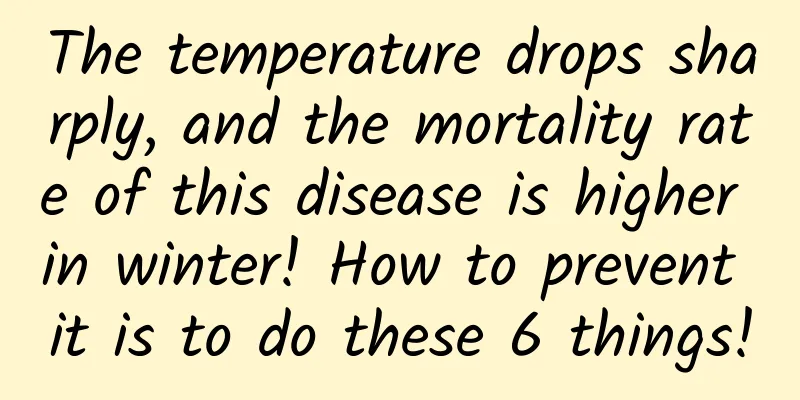The temperature drops sharply, and the mortality rate of this disease is higher in winter! How to prevent it is to do these 6 things!

|
A few days ago, I received such a patient, 62-year-old Mr. Li, who was in good health with only a slight hypertension. He insisted on running in the park near his home every morning. One morning a few days ago, the outdoor temperature had dropped to more than ten degrees below zero. He went to the park for morning exercise despite his family's dissuasion. As a result, he suddenly fainted on the snow after running a few steps. He was sent to the hospital and diagnosed with acute myocardial infarction. The ventricular wall was necrotic due to ischemia. He was saved after full rescue. We also have this experience in life, that is, winter is often more difficult for the elderly, and a report published in the American Heart Association's journal Circulation also shows that the death rate from heart disease rises sharply in cold air or in extremely cold climates, and people with cardiovascular diseases are more likely to experience a "blowout". Therefore, in winter, the season with a high incidence of cardiovascular diseases, it is very important to learn how to protect the heart, especially for the elderly who suffer from hypertension, diabetes or comorbid cardiovascular diseases. So, what should we pay attention to in our daily lives? And how should we prevent it? First, the conclusion is the following table: Next, let’s talk about some of them in detail. 01 Keep warm The weather is cold in winter, and cold air stimulates blood vessels to constrict, which leads to insufficient blood supply to the cardiovascular and cerebrovascular systems, and then induces cardiovascular diseases. Therefore, people need to keep warm in their daily lives and avoid severe cold stimulation. When going out, pay attention to adding clothes, and wear masks, gloves, scarves and hats when going out. When the wind is strong and the temperature drops, try not to walk against the wind, and try to reduce going out on snowy days. In life, some elderly people do not turn on air conditioning or heating to save money. Children, relatives and friends should persuade them to provide a comfortable indoor environment for heart patients. 02 Prevent colds and get vaccinated Winter is a season of high incidence of respiratory infections, as the weather is dry and the temperature difference between indoor and outdoor is large. Respiratory diseases, especially colds, pneumonia and bronchitis, can induce underlying organic heart disease, cause heart failure, and aggravate heart failure, forming a vicious cycle. Pay attention to personal hygiene and try not to go to crowded public places. If necessary, get the flu and pneumonia vaccines. Once you have symptoms of respiratory infections such as colds, coughs and sputum, you should seek medical attention in time, especially for patients with underlying organic heart disease, to avoid worsening of the condition. Considering the current prevalence of new coronavirus infection and its harm to the elderly, it is recommended that elderly people who meet the vaccination conditions take good protection and receive the new coronavirus vaccine in a timely manner. 03 Eat right and control your weight There are many festivals and gatherings in winter, and the low temperature can increase our appetite. In addition, we are busy at the end of the year and the beginning of the year, and lack time to control our weight, which increases the burden on our body. On weekdays, we should emphasize the intake of fresh vegetables, fruits, beans, nuts, whole grains and fish, reduce the total fat in the diet, especially the content of saturated fatty acids, limit excessive sodium intake (no more than 5 g of salt per day), and avoid overeating. Control your weight, keep your BMI < 24kg/m², and your waist circumference < 90/85cm (male/female). Men should especially avoid having a jujube-shaped body with fat chest and abdomen. In short, no matter how good the food is, you can't eat too much. 04 Quit smoking and limit alcohol consumption A large number of epidemiological studies at home and abroad have shown that smoking or passive inhalation of secondhand smoke will increase the risk of cardiovascular disease and death, such as coronary heart disease, heart failure, and stroke, and there is no safe smoking dose. The more you smoke, the longer you smoke, and the younger you start smoking, the greater your risk of cardiovascular disease. After quitting smoking, the risk of cardiovascular disease decreases rapidly. Studies have shown that quitting smoking at the age of 30, 40, or 50 can extend your life expectancy by about 10 years, 9 years, or 6 years, respectively. The relationship between drinking and cardiovascular disease is complex. People with hypertension, diabetes, atrial fibrillation, impaired liver and kidney function, as well as pregnant women and adolescents are not recommended to drink alcohol. The general population is also not recommended to prevent cardiovascular disease by drinking small amounts of alcohol. The Dietary Guidelines for Chinese Residents recommend that daily alcohol intake should not exceed 25 g for men and 15 g for women. The amount of alcohol consumed is calculated as the alcohol content indicated on the bottle (%, v/v) × amount consumed (ml)/100 × 0.8 (g/ml). For example, if you drink 1 liang (50 ml) of liquor, the alcohol content indicated on the bottle is 52 degrees (52%, v/v), and the actual alcohol intake is 50 (ml) × 52/100 × 0.8 (g/ml) = 20.8 (g) of alcohol. 05 Exercise There is a habit of "hibernating" in high-altitude cold regions, which is very unfavorable for patients. A large amount of previous research evidence shows that insufficient physical activity is related to the incidence of cardiovascular and metabolic diseases, and increasing physical activity and reducing sedentary time can have obvious benefits. In the short term, it can reduce anxiety and lower blood pressure. In the long term, it can reduce the incidence of chronic diseases such as hypertension, diabetes and cardiovascular disease, and can reduce the risk of death and increase life expectancy. It should be noted that outdoor activities in winter should be done at different times. The temperature is low in the morning in winter, and the resilience of human blood vessels is poor, which is a high-incidence period for acute cardiovascular diseases. Therefore, morning exercises should not be done too early. It is best to choose the time when there is sunlight between 10 am and 4 pm, such as brisk walking, jogging, strolling, Tai Chi, Ba Duan Jin, etc. Choose the appropriate exercise method according to age and underlying diseases. Patients with cardiovascular diseases are advised to undergo cardiopulmonary function assessment and gradually perform aerobic exercise according to exercise prescriptions under the guidance of cardiac rehabilitation doctors to improve cardiopulmonary function. The 2020 Chinese Cardiovascular Disease Primary Prevention Guidelines recommend that healthy adults should engage in at least 150 minutes of moderate-intensity physical activity or 75 minutes of vigorous-intensity physical activity (or an equivalent combination of moderate-intensity and vigorous-intensity physical activity) per week. For adults who are unable to reach the recommended amount of activity due to illness or physical condition, moderate or vigorous-intensity physical activity below the recommended amount can also help reduce the risk of cardiovascular disease. Moderate-intensity physical activity means that the heart rate reaches 60% to 70% of the maximum heart rate [(beats/min) = 220-age] during the activity. The forms of activities include cycling (speed < 16 km/h), walking (speed ≤ 6.4 km/h), dancing (social dance, square dance, etc.), and household activities (such as making beds, moving tables and chairs, mopping the floor, hand washing clothes, sweeping carpets, etc.). High-intensity activities include race walking or running (speed ≥ 8 km/h), cycling (speed ≥ 16 km/h), skipping rope, swimming, basketball, football, weighted mountain climbing (weight ≥ 7.5 kg), etc. 06 Take medicine on time and follow up regularly In winter, blood pressure, blood lipids, and blood sugar are prone to fluctuations, especially for the elderly with chronic diseases such as cardiovascular diseases. On weekdays, we should strengthen monitoring, follow the doctor's advice to take medication regularly, and follow up regularly to avoid intermittent medication, which will lead to fluctuations in the condition and cardiovascular and cerebrovascular events. In addition, we should also pay attention to the management of blood pressure, blood sugar, and blood lipids. Blood Pressure Management: It is recommended that all patients with hypertension and those with high normal blood pressure adopt lifestyle interventions (weight control, increased physical activity, salt restriction, moderate alcohol consumption, low-fat diet, and increased fruit and vegetable intake); Hypertensive patients should keep their blood pressure below 140/90 mmHg; Blood pressure of elderly patients with hypertension (≥65 years old) should be lowered to <150/90 mmHg. If the patient can tolerate it, it can be further lowered to <140/90 mmHg. For patients with diabetes, stroke, myocardial infarction, renal insufficiency and proteinuria, it is best to lower blood pressure to below 130/80 mmHg, provided that the patient can tolerate it. Blood sugar management: Lifestyle intervention is the basic treatment measure for type 2 diabetes and should be carried out throughout the treatment; For most non-pregnant adults with type 2 diabetes, a reasonable HbA1c control target is <7%; It is recommended that patients with type 2 diabetes have a fasting blood sugar of 4.4-7.0mmol/L and a non-fasting blood sugar of <10mmol/L; Lipid Management: Adopt a healthy lifestyle, control dietary cholesterol intake, and limit the intake of foods rich in saturated fatty acids, including most biscuits, cakes, French fries, potato chips and other fried foods and processed snacks; In short, elderly people with cardiovascular disease are indeed at higher risk in winter than usual, and we should be more careful. References: [1] Gu Dongfeng, Weng Jianping, Lu Xiangfeng. Chinese Guidelines for Healthy Lifestyle to Prevent Cardiometabolic Diseases[J]. Chinese Journal of Circulation, 2020, 03: 209-230. [2] Chinese Center for Disease Control and Prevention. 2018 China Adult Tobacco Survey Report[M]. Beijing: People's Medical Publishing House, 2020. [3] Chinese Society of Cardiology, Chinese Society of Rehabilitation Medicine, Cardiac Prevention and Rehabilitation Committee, Chinese Society of Gerontology and Geriatrics, Cardiology Committee, Chinese Medical Association, Cardiovascular Medicine Branch, Thrombosis Prevention and Treatment Committee. Chinese Guidelines for Primary Prevention of Cardiovascular Diseases[J]. Chinese Journal of Cardiology, 2020, 12:1000-1038. Author: Tang Yilong Review | Tang Qin, Chief Researcher, Science Popularization Department, Chinese Medical Association |
>>: What are the dangers of trans fatty acids and in which foods are they found?
Recommend
What are the functions of the Lanzhou community property management mini program? How much does it cost to develop a property management app?
In order to improve the management efficiency of p...
In addition to Google, they are also developing driverless technology
At Google's I/O Global Developer Conference, ...
Why can the price of the same bottle of soy sauce vary by 5 times? The truth behind it...
When it comes to soy sauce, I believe everyone is...
What are the functions of the clock-in attendance mini program? How to create a WeChat check-in app?
Not long ago, a customer consulted the editor. Si...
Why deploy influencer marketing?
Although it seems that the term " influencer...
Yu Chengdong visits BAIC, and the company officially confirms that the Arcfox HBT equipped with Huawei solution will be delivered within this year
Recently, Huawei Consumer BG CEO Yu Chengdong, Gl...
How much does it cost to create the Yichun flash sale mini program? Yichun flash sale applet production price inquiry
The factors affecting the quotation of Yichun fla...
Is it expensive to produce the Yulin Textbook Mini Program? Yulin textbook applet production cost
How much does it cost to produce the Yulin Textbo...
BAT and other companies are working together to eliminate traditional TV brands from the smart TV industry
An industry field that is collectively favored an...
Detailed explanation of the characteristics of information flow promotion channels such as Toutiao and Weibo!
If we want to do information flow promotion , cha...
Do you know how the Segway boss died? Balance bikes are still a little bit behind in their road use
As a means of transportation that combines fashio...
How big is the pond? Scientists give the first accurate number
Almost everyone can identify a pond, but what exa...
A well-known singer died of illness. What is the culprit, "melanoma"?
Audit expert: Zhang Yuhong Chief Physician of Der...
[Dry Goods] Common data analysis table headers and assessment indicators for operations positions (I)
Internet operations are inseparable from various ...
Seeing the Earth's rotation with the naked eye! This scene is so shocking
"I saw the earth's rotation with my nake...









